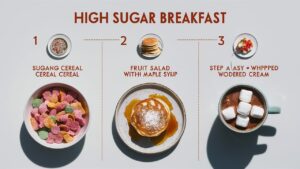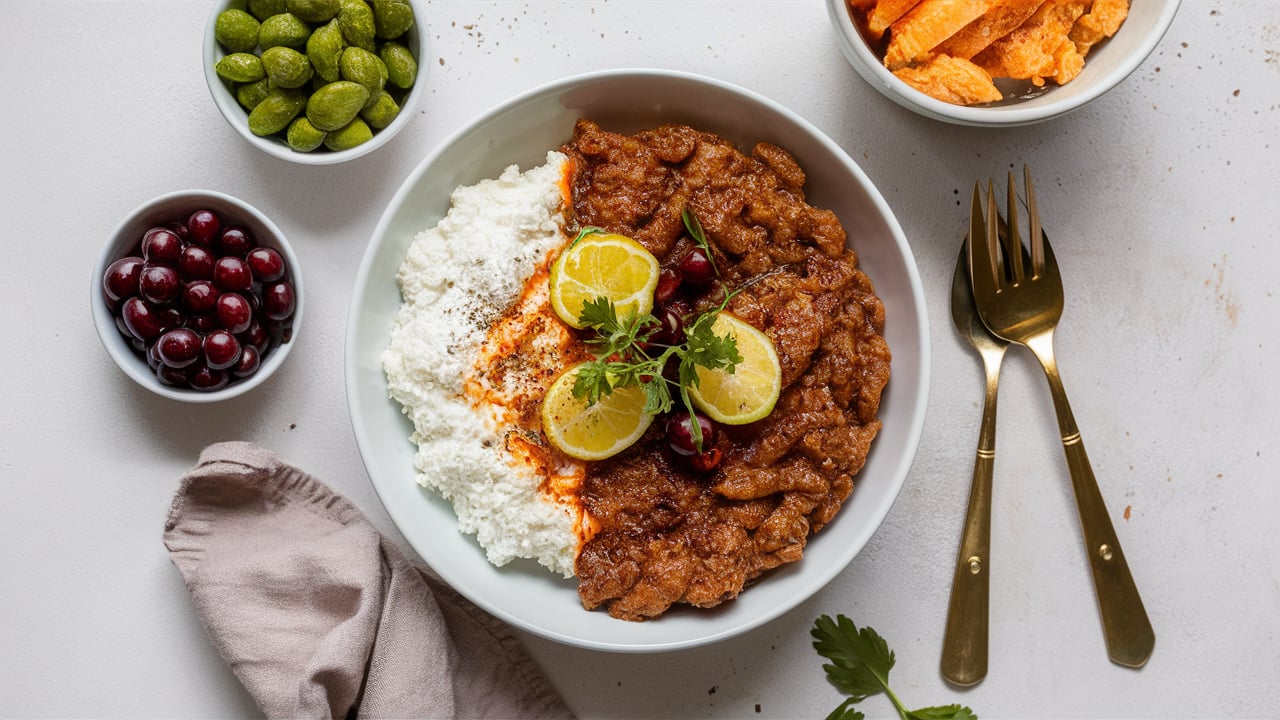Breakfast is often regarded as the most important meal of the day, yet the way you start your morning can significantly impact your health. If your breakfast includes foods and beverages high in added sugars, you may unknowingly be setting yourself up for a day of energy crashes and health risks. In this guide, we’ll explore what defines a high sugar breakfast, the effects it can have on your well-being, and offer healthier alternatives to help you start your day on the right note.
Part 1: Understanding High Sugar Breakfasts
What is a High Sugar Breakfast?
A high sugar breakfast is characterized by foods and drinks that contain large amounts of added sugars. These sugars are often found in processed breakfast items like sugary cereals, pastries, and sweetened beverages. While these foods might provide a quick energy boost, they can lead to a mid-morning crash and negatively affect your health in the long run.
Sugary breakfasts can spike your blood sugar levels rapidly, causing a burst of energy followed by a sharp drop, leading to feelings of fatigue, hunger, and cravings for more sugar. Over time, consuming high amounts of sugar in your breakfast can contribute to weight gain, mood swings, and an increased risk of chronic diseases.
Types of Sugars in Breakfast Foods
It’s essential to differentiate between the types of sugars found in breakfast foods:
- Added Sugars: These are sugars that are added to foods during processing or preparation. Common sources include sugary cereals, pastries, and flavored yogurts.
- Natural Sugars: These sugars occur naturally in whole foods like fruits, vegetables, and dairy products. Although they contribute to the sugar content, they come with additional nutrients such as fiber, vitamins, and minerals, making them a healthier option than added sugars.
How Much Sugar Is Considered High?
According to the American Heart Association, the recommended daily intake of added sugars should not exceed 25 grams (6 teaspoons) for women and 36 grams (9 teaspoons) for men. A high-sugar breakfast can easily surpass these limits, particularly when multiple sugary foods and drinks are consumed together. For example, a bowl of sugary cereal with flavored yogurt and a glass of fruit juice can contain over 40 grams of sugar—well above the recommended daily intake before your day has even begun.
Part 2: Common High Sugar Breakfast Foods
Many breakfast foods are loaded with hidden sugars, even those marketed as healthy. Here are some of the most common high-sugar breakfast culprits:
1. Sugary Cereals
Sugary cereals are a popular breakfast choice, but they often contain high levels of added sugars. Cereals targeted at children, in particular, can contain 10-15 grams of sugar per serving, equating to 2-3 teaspoons of sugar.
- Examples: Frosted flakes, honey nut cereals, chocolate-flavored cereals.
- Impact: These cereals can cause a rapid spike in blood sugar, leading to a crash and feelings of fatigue later in the morning.
2. Flavored Yogurts
While yogurt can be a nutritious breakfast option, many flavored varieties are packed with added sugars. Fruit-flavored yogurts can contain up to 20 grams of sugar per serving, much of which comes from added sweeteners rather than natural fruit.
- Examples: Fruit-flavored yogurts, vanilla yogurt, dessert-flavored yogurts like chocolate or caramel.
- Impact: The high sugar content can contribute to weight gain and an increased risk of diabetes when consumed regularly.
3. Pastries and Baked Goods
Pastries such as muffins, donuts, and cinnamon rolls are classic breakfast items, but they are often loaded with sugar and refined carbohydrates. These foods are designed to taste sweet and indulgent but can quickly lead to high sugar consumption.
- Examples: Donuts, croissants with chocolate or fruit fillings, bakery muffins.
- Impact: These high-sugar pastries can cause a quick energy spike followed by a crash, leaving you feeling tired and craving more sugar.
4. Pancakes and Waffles with Syrup
Pancakes and waffles are often considered a weekend breakfast treat, but when topped with syrup, whipped cream, and powdered sugar, they can become a sugar bomb.
- Examples: Pancakes with maple syrup, Belgian waffles with whipped cream.
- Impact: The combination of refined flour and sugary toppings can lead to a rapid increase in blood sugar levels, causing energy crashes and cravings later in the day.
5. Sweetened Beverages
Many people start their day with a sweetened coffee or fruit juice, but these drinks can add significant sugar to your breakfast without providing much nutritional value. A single glass of fruit juice or a flavored coffee drink can contain as much as 30-40 grams of sugar.
- Examples: Sweetened coffee drinks, flavored lattes, fruit juices, sweetened teas.
- Impact: Sugary drinks contribute to a high sugar intake without the fiber or nutrients that help balance blood sugar levels.
For more ideas on sweet breakfast options, check out these sweet breakfast recipes.

The Impact of a High Sugar Breakfast on Your Health
Regular consumption of high-sugar breakfasts can have numerous negative effects on your health, both short-term and long-term. Here are some key ways that a sugary breakfast can impact your overall well-being:
1. Blood Sugar Spikes and Crashes
High-sugar breakfasts can cause rapid blood sugar spikes, followed by crashes, leading to feelings of fatigue, irritability, and hunger. This cycle can make it challenging to stay productive throughout the morning and often results in reaching for unhealthy snacks.
2. Weight Gain
Sugary breakfasts are typically high in calories but low in nutrients, meaning they don’t keep you full for long. This can lead to overeating later in the day and contribute to weight gain. Additionally, high sugar intake can cause insulin resistance, which makes it harder for your body to regulate blood sugar levels.
3. Increased Risk of Chronic Diseases
Long-term consumption of sugary breakfasts increases your risk of developing chronic diseases like heart disease, type 2 diabetes, and certain cancers. High sugar intake is linked to inflammation in the body, which plays a role in the development of these conditions.
4. Impact on Mood and Mental Health
A high-sugar breakfast can negatively impact your mood and mental health. The rapid fluctuations in blood sugar caused by sugary foods can lead to irritability, anxiety, and difficulty concentrating. Over time, a high-sugar diet has been linked to an increased risk of depression.
Healthier Alternatives to High Sugar Breakfasts
If you’re looking to reduce your sugar intake while still enjoying a delicious and satisfying breakfast, there are plenty of healthier alternatives available:
1. Low-Sugar or No-Sugar Cereals
Instead of reaching for sugary cereals, opt for low-sugar or no-sugar options made from whole grains. These cereals are often higher in fiber, keeping you full and energized throughout the morning.
- Examples: Plain oatmeal, unsweetened whole grain cereals, bran flakes.
- Tip: Add fresh fruit, nuts, or a drizzle of honey for natural sweetness without the added sugars.
2. Plain Greek Yogurt with Fresh Fruit
Opt for plain Greek yogurt instead of flavored varieties, and add your own fresh fruit for natural sweetness. Greek yogurt is high in protein and low in sugar, making it a healthier choice.
- Examples: Plain Greek yogurt topped with berries, sliced bananas, or a handful of granola.
- Tip: Add a sprinkle of cinnamon or a drizzle of honey for extra flavor without overloading on sugar.
3. Homemade Breakfast Pastries
If you love pastries in the morning, try making your own at home using healthier ingredients. You can control the amount of sugar and choose whole grain flours to boost the nutritional content.
- Examples: Homemade muffins made with whole wheat flour, banana bread sweetened with applesauce.
- Tip: Use natural sweeteners like honey or mashed bananas to reduce added sugars.
For a fun breakfast idea, try these crescent roll breakfast recipes.
4. Protein-Packed Pancakes and Waffles
You don’t have to give up pancakes and waffles to eat a healthier breakfast. By making simple swaps, you can create a more nutritious version of your favorite breakfast foods.
- Examples: Pancakes made with almond flour, waffles made with whole grains and topped with fresh fruit.
- Tip: Instead of syrup, top your pancakes or waffles with Greek yogurt, nut butter, or a sprinkle of chia seeds for added nutrition.
5. Unsweetened Beverages
Instead of starting your day with sugary beverages, choose unsweetened drinks that provide hydration without the added sugars.
- Examples: Black coffee, unsweetened herbal tea, water with a splash of lemon or lime.
- Tip: If you prefer a little sweetness in your coffee, try using natural sweeteners like stevia or monk fruit.
Tips for Reducing Sugar in Your Breakfast
Here are some practical tips to help you cut back on sugar in your breakfast while still enjoying a flavorful meal:
- Read Labels Carefully: Check nutrition labels for added sugars and choose products with minimal sugar content. Focus on whole, unprocessed foods whenever possible.
- Prioritize Protein and Fiber: Protein and fiber-rich foods like eggs, Greek yogurt, and whole grains can help keep your blood sugar levels stable and prevent cravings.
- Make Small Swaps: Start with small changes, like swapping sugary cereals for plain oatmeal or using fresh fruit instead of syrup on pancakes.
- Prepare Breakfast at Home: Preparing your breakfast at home gives you control over the ingredients and allows you to reduce added sugars.
- Be Mindful of Portion Sizes: If you’re enjoying a sweet breakfast, keep your portions small and balance them with other nutrient-dense foods.
For more inspiration on healthy breakfast options, check out what is a good breakfast dessert for ideas that balance taste and nutrition.

Conclusion: The Dangers of High Sugar Breakfasts
High sugar breakfasts might be convenient and tasty, but they can lead to a range of health issues, from weight gain to an increased risk of chronic diseases. By making small changes to your breakfast routine, such as choosing low-sugar cereals or opting for homemade pastries, you can start your day with a meal that provides sustained energy and nourishment.
FAQs
- How much sugar is too much for breakfast?
- The American Heart Association recommends no more than 25 grams (6 teaspoons) of added sugar per day for women and 36 grams (9 teaspoons) for men. It’s best to limit added sugars in your breakfast to stay within these guidelines.
- What are some low-sugar breakfast options?
- Low-sugar breakfast options include plain oatmeal, Greek yogurt with fresh fruit, scrambled eggs with vegetables, and smoothies made with unsweetened ingredients.
- Can I still enjoy sweet breakfast foods in moderation?
- Yes, you can enjoy sweet breakfast foods in moderation. The key is to balance them with protein, fiber, and healthy fats to avoid blood sugar spikes and crashes.

